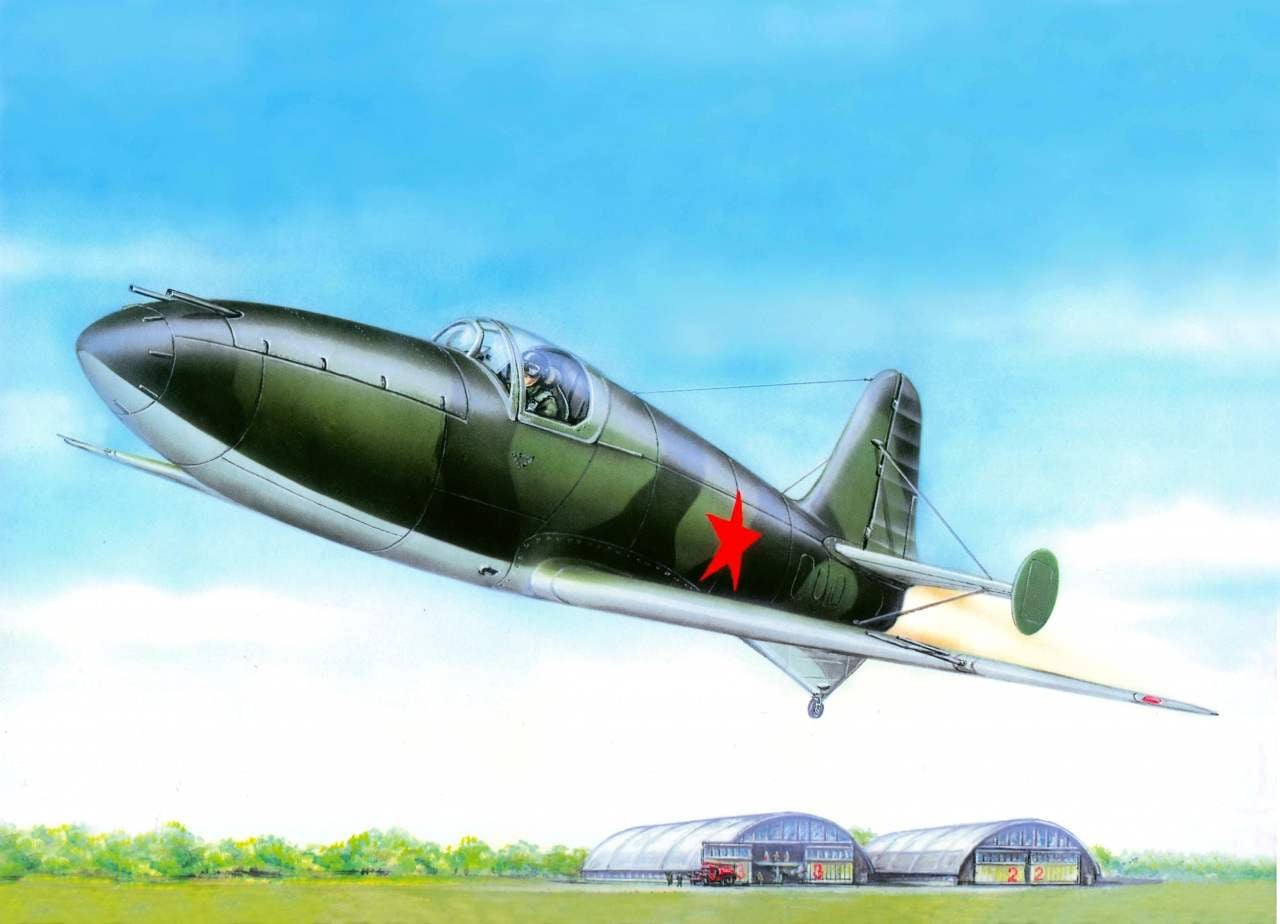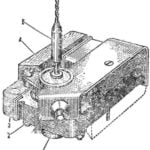 On the drawing Board stood out the contours of a completely new fighter, interceptor unprecedented for that time qualities. He will not have to look for enemy bombers — a plane meteoric rise when they enter in the area of its action. A monstrous climb rate will enable an interceptor for a few seconds to attack enemy aircraft, leaving his pilots time maneuvering.
On the drawing Board stood out the contours of a completely new fighter, interceptor unprecedented for that time qualities. He will not have to look for enemy bombers — a plane meteoric rise when they enter in the area of its action. A monstrous climb rate will enable an interceptor for a few seconds to attack enemy aircraft, leaving his pilots time maneuvering.
This was to become the first domestic missile interceptor BI-1, so named by the names of its creators—Alexander Yakovlevich Bereznyak and Alexei Mikhailovich Isayev Here only the main data of the aircraft, which looked then, on the eve of the great Patriotic war, it is a fantastic maximum speed of the earth — 900 km/h lift time to a height of 5 thousand meters — 1 minute, to a height of 10 thousand meters — 1.5 min, weight of the aircraft -1500 kg, the engine weighs 45 kg, vooruzhenie two 12.7-mm machine gun and two 7.62 mm machine guns or two 20-mm aircraft cannon.
The story of the creation of BI-1 it is possible to start from January 1938, when the Moscow aviation Institute defended the project of high-speed aircraft made by student Alexander Bereznyak under the guidance of the famous aircraft designer V f Bolkhovitinov Car was twin-engined, with the engine located in the fuselage in tandem, with a very clean aerodynamic shape without protruding elements of light or visors.
The plane, which was supposed to exceed the speed of 700 km/h, became interested in air force leadership, and Alexander Bereznyak was sent to OKB Bolkhovitinov In f for the project.
To achieve the high speeds of the new aircraft at OKB designers worked on several versions of combined power plants, of which the most promising was a combination of reciprocating engine with ramjet (RAMJET engine) and the liquid rocket engine (LRE) with RAMJET But they were too greedy and, most importantly, did not provide the desired speed.
“I was once on a yard of research Institute — later recalled doctor of technical Sciences, Chief designer And I’m the birch —Hear the thunder the Sky is clean as a whistle, and the thunder Realized the earth thunder was curious— went to sound. Immensely surprised when I saw that the thunder spewing a small engine similar to a pot hole Around him were working three or four people Asked “What’s the gimmick?” Senior proudly replied “the Jet engine”.

BI-1
What if the plane only to put a rocket engine? With this in mind, berezniak, who by that time the crew chief came to consult with Chief designer Bolkhovitinov immediately appreciated the attractiveness of the scheme aircraft with a single engine — although quite voracious, but at the same time a light, powerful and compact At the beginning of 1941 to the A M Isaev, who worked in the Bureau chief of the brigade of engines Initially, the work was proactive—the designers had to design a rocket plane in hours nevertheless the work progressed, although it was not clear in the main—it was hindered by the lack of reliable rocket engine.
However, the right engine, however, existed In the Jet propulsion research Institute (RNII) at this time on the creation of a broad range of rocket engine worked Leonid Stepanovich Dushkin One of these engines. oboznacheniya D-1-A-1100, had quite a suitable thrust 1100 kg, but, unfortunately, was half-cocked—it requires a fairly complex turbo-pump unit, feed fuel and oxidizer into the combustion chamber focus on the particular engine have started looking for designers, however, implement them after hours it was already it was hard again to ask stastia have Bolkhovitinov he approved of the idea, promised to do everything to facilitate the work on the rocket plane, but to spend time in a service initiative project is still not allowed.
However, the design of the rocket plane continued Remained the only serious problem—the creation of a turbopump unit Not relying on engine specialists, for his design came from Isaev, but soon realized that the plane that complex Assembly is not necessary, but is it necessary at all? Because fuel can be expelled from the cylinders with compressed air! In the end, the new layout made it possible to bring the ground plane up to a ton and a half (instead of three) of fuel he needed less, and the speed and rate of climb promised to be significantly higher.

The first Russian rocket plane BI-1:
1 — 20mm cannon, 2 — pedal control of the aircraft at the rate of 3 — the pilot’s seat, 4 — canopy of canopy pilot, 5 — slide of the lantern, 6 Pitot, 7 — Aileron, 8 — console wing, 9 — panel, 10 — antenna radio 11 — flight instruments panel, 12 — panel control and measuring devices of the propulsion system, 13 — main landing gear, 14 — tail wheel, 15 — Kiel, 16 — rudder, 17 — Elevator, 18 — cover a niche of the main chassis, 19 — kitava washer, 20 — control knob
The war spurred the work on the aircraft, and in early July 1941 preliminary design of a missile interceptor was sent to the State Defense Committee and the Military Council of the air force In late August, the designers summoned the people’s Commissar of aviation industry Shakhurin And And and reported that the project is approved, and the delivery of the finished aircraft must be held within a month a half-Hearted objections of the designers that the minimum term for such aircraft is three to four months, not persuaded Commissar Only thing he has allowed is to add developers for five days.
Unbelievable, but exactly on time the plane rolled out of the Assembly shop with no engine I had to fly a new fighter, lifting him into the air towed behind a bomber Test was entrusted to an experienced pilot, ex glider pilot Boris N. Kudrin Motorless flights showed that the aircraft has good handling and stability and it is suitable for installing it on the rocket engine.
The interceptor was a all-wood monoplane with a length of 6.9 m low wing span 6.6 m Fighter was equipped with retractable landing gear, had a closed pilot’s cabin.
Rocket engine D-1A-1100 design L Dushkin, who worked on kerosene and nitric acid is displaced from the tanks by compressed air, was mounted in the rear fuselage fuel Tanks (kerosene) was located in the front part of the fuselage with the oxidizer (nitric acid) in the middle part of the Cockpit is thus located between butovymi compartments. The first instance of BI-1 was armed with two 20-mm aircraft guns.
To continue testing of the airplane with a liquid rocket engine was only in may 1942, in the village of bilimbay near Sverdlovsk, where evacuated OKB Bolkhovitinov For testing of the interceptor from the air force Institute sent the pilot, captain Grigory Yakovlevich Bakhchivandzhi, replacing diseased Kudrin, by the Way, Bakhchivandzhi by that time had 70 combat missions and shot down six enemy aircraft.
The first “fire” started on may 15, 1942 After the command “tail!” from the nozzle of the combustion chamber of the engine flashed a fiery torch with a length of 3-4 meters, there was a deafening roar, the plane took off and after a 10 second run off the ground and began to gain altitude After the engine operating plane, describing a semi-circle, came in for a landing, the Landing was not without incident in flight In the cockpit entered a pair of nitric acid, make it difficult to orientation, so Bakhchivandzhi has been unable to “grind” the car to the ground as a result of BI-1 was podloman landing gear.

Layout B-1:
1 — liquid propellant rocket engine, 2 — tail wheel chassis, 3 — the radio antenna, 4 — cockpit, 5 — Pitot, 6 — tanks with oxidizer — nitric acid, 7 — 20 mm cannons, 8 tanks of fuel – kerosene, 9 — wheel main landing gear
Work on rocket fighter continued, however it so Happened that the engine-builders [of the RNII had to come to grips with the rocket plane, developed in their Institute, so OKB Bolkhovitinov remained without specialists in the LRE. Had to charge the debugging engine And M Isaev.
Test B-1 continued in January 1943 In the third flight, in particular, there have been very high for those times speed— 630 km/h However, problems in the engine did not allow to fully test the interceptor in February 1943, part of the OKB Bolkhovitinov was created by the design Bureau of engines (CDB) to manage entrusted with A M Isaev. In this KBD created RD-1—new engine for missile interceptor Test B-1 continued, however In one of the flights, the interceptor gained the height of 3 thousand meters in 30 seconds, so the climb rate of a rocket plane more than five times exceeded the figure of the best fighters of the time.
March 27, 1943, he took flight of BI-1 at maximum speed, ended tragically In 1944, the OKB Bolkhovitinov entered RNII By this time the b-1 was installed rocket engine RD-1, created A M Isaev on the basis of D-1-A-1100, the New engine had an adjustable rod from 3.9 to 11.8 kN, the weight was 95 kg, the length of the camera is 0.8 m RD-1 could be run many times in flight, and his life was 30 minutes, the Ignition was carried out with arc buscacom, representing a pair of electrodes, which were introduced in the nozzle of the engine, where he started to withdraw and open the Resulting arc burned fuel components, and the electrodes are withdrawn from the nozzle of the Main rocket engine parts were made of acid resistant steel.

Rocket engines of the plane BI-1 thrust 1100 kg:
A — D-1-A-1100 design L. Dushkin (O — oxidizer G — fuel), B — RD-1 designed by A. Isayev
At the same time was lightweight propulsion system and increased fuel capacity the Design of the airframe is not changed New motor unit operating at a nominal thrust 61, and then in accordance with a decrease in pressure of the fuel feed thrust gradually decreased to 60 percent of the rated Takeoff weight of a rocket plane was a little more than 1800 kg, including the mass of the airframe amounted to 634 kg, propulsion — 362 kg of fuel — 569 kg, compressed air -16,8 kg, the pilot parachute is 90 kg, weapons — 126 kg and test apparatus— 18.5 kg Maximum design speed of the aircraft—860 km/h.
BI-1 with the new engine was tested as a test pilot of B N Kudrin on 24 January and 9 March 1945, In the process of flying the engine was running steadily and smoothly, and the plane when the angle of climb to 33-34 degrees reached speed of 587 km/h With a horizontal acceleration acceleration of the plane is 18.7 km/h 1 S.
After the war the need to create a rocket fighter-interceptor disappeared in addition To this time, the approach was the first jet aircraft of the new generation of turbojet engines.
I. ANASTASYINSKY



